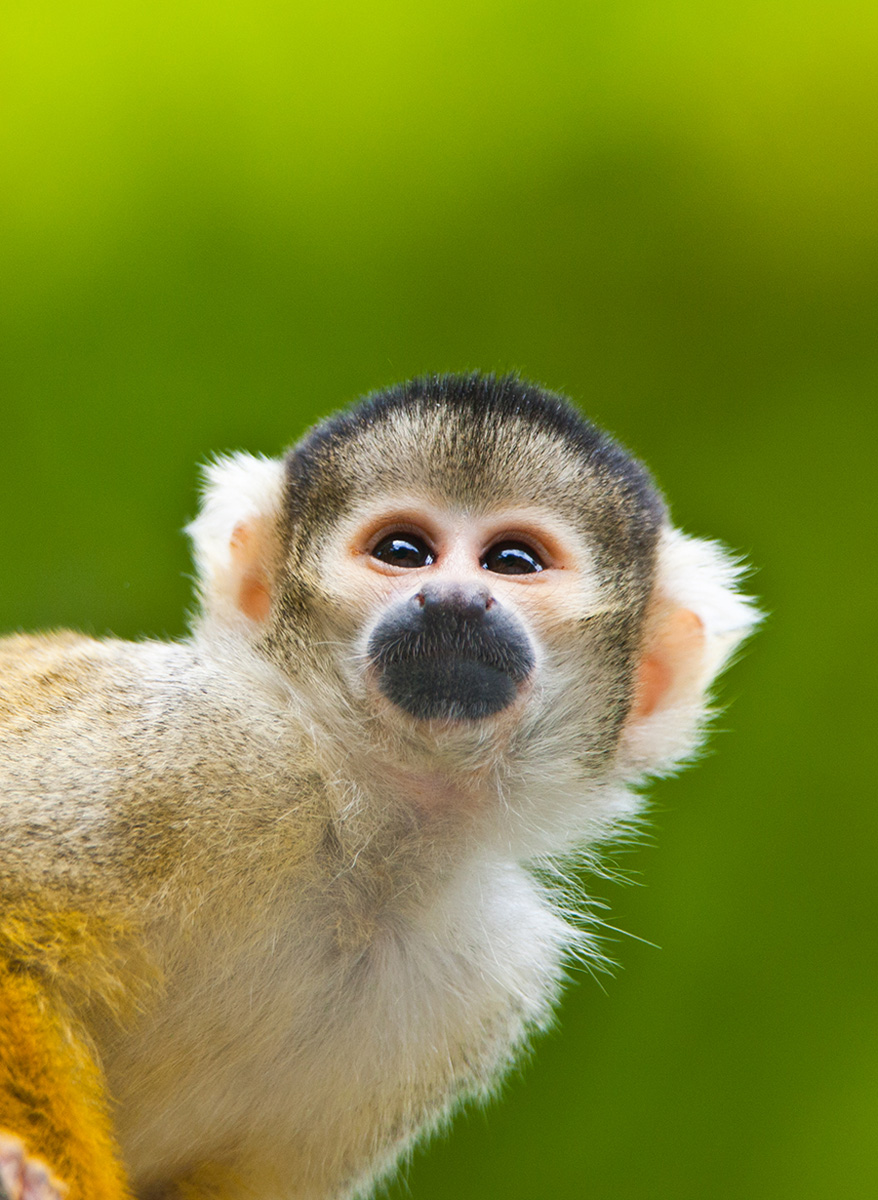Bornean orangutan
Pongo pygmaeus
Habitat
Lowland rainforests and swamp woodlands
Food
Fruit, leaves, bark
Weight
♂ ± 90 kg; ♀ ± 40 kg
Age
40 to 50 years
IUCN Status
Ernstig bedreigd
Appearance
Orangutans are great apes. Together with gorillas, bonobos and chimpanzees, they are the primates that most resemble humans. They are recognisable by their distinctive reddish-orange, shaggy fur. And their arms are exceptionally long, too. The males have a span of up to 2.5 metres! Orangutans have such long arms for a good reason: it helps them live high up in the trees. Their hands and feet are also perfectly adapted to this life. For example, orangutans have opposable thumbs and big toes. That means they can touch their other fingers and toes with their thumb and big toe. This allows them to hold on exceptionally well.
Adult male orangutans have an additional striking physical feature. Some adult males develop large cheek pads called flanges around their face. This happens at different times for different individuals. And not all males develop into flanged males. This development can be stunted by the presence of other flanged males in the vicinity. Besides growing cheek pads, adult males also grow to be about twice as heavy as the females and their hair grows extremely long. They also develop a throat sac. This enables them to make what is known as a ‘long call’, a loud, grating call which they use to attract females. Impressive!
Habitat
Bornean orangutans live on the Indonesian island of Borneo. They live in the island’s tropical rainforests and swamp woodlands.
Lifestyle
Orangutans live a semi-solitary life. So, in the wild you do not often see them with others of their species. The other great apes (gorillas, bonobos and chimpanzees) live in social groups. When orangutans encounter each other in the wild, it usually passes off without incident. They share some food and then carry on their separate ways.
Behaviour
Of all the great apes, orangutans spend most time in the trees. They are calm and move slowly because they are so large. Flanged males use ‘long calls’ to tell females where they are. You can hear this long call almost 1.5 kilometres away! This is also a way of keeping other flanged males out of the vicinity. When two flanged males meet, it often leads to a serious fight and the males can be seriously injured during these encounters.
Reproduction
In the wild, female orangutans usually have their first baby when they are about fifteen years old. The young are born after an incubation period of about 8.5 months. A newborn orangutan weighs about two kilos. For the first few years of its life, the young orangutan and its mother are inseparable. The mother raises the young on her own, males are not involved at all. For the first few months the young orangutan simply holds on to its mother all the time. Young orangutans suckle milk from their mothers until they are about four years old. Between the ages of two and four, orangutans start venturing out on their own more and more. The mother gradually teaches the young orangutan everything it needs to know: what they can and cannot eat, how to climb, how to build a sleeping nest, which fruits are ripe and even handy routes through the trees. The process of raising a young orangutan lasts about eight years, which is exceptionally long for primates. This is partly because orangutans live semi-solitary lives. So they do not have any other group members to learn from. Ultimately, all young orangutans leave their mothers when they are eight years old. Then they go in search of a partner so they can reproduce too.
Situation in the wild
Orangutans in the wild are in danger of extinction. Their habitat is under serious threat. One of the reasons for this is the establishment of palm oil plantations. Humans chop down sections of rainforest to make room for palm oil plantations. Producing palm oil is a profitable business as it is included in numerous products we humans use, such as soap and food. People also hunt orangutans. If we fail to take action, orangutans will go extinct in the near future. That is why we try to educate Apenheul visitors about the palm oil industry and how they might be involved in it themselves.

The Apenheul Primate Conservation Trust
Apenheul also works to protect orangutans in the wild. In Indonesia, the Apenheul Primate Conservation Trust supports the Kinabatangan project. Among other things, this project looks at how orangutans might be able to survive in the rainforests of Borneo which have been so affected by human activity.
At Apenheul
The orangutans at Apenheul enjoy playing games. That is why there are special orangutan puzzles on the Apenheul’s orangutan island. The keepers hide tasty morsels inside. Then the orangutans have to poke the snacks out with a stick. We call this enrichment. It encourages the orangutans’ creative and natural behaviour. You can try one of the same puzzles yourself when you visit Apenheul!
Population management programme
Apenheul is part of the European endangered species programme (EEP) for orangutans. Together with other zoos, we actively strive to maintain genetically healthy populations of orangutans. And we are succeeding. In recent years more and more healthy baby orangutans have been born. Since 2017 there are even three generations of orangutans living in our zoo: grandma Sandy, daughter Samboja and granddaughter Indah. Amazing!
Fun facts
In Malay, orangutan means ‘man of the forest’. That makes sense, because of all the great apes, orangutans spend the most time in the trees.
Every day, orangutans build two sleeping nests, one for the afternoon and one for the night. They build them in trees.
Want to see the orangutans at Apenheul?
Get your tickets now and spot all the primate species!

Welcome to Apenheul
Open for business events
Park open from Friday 20 March, 10.00 hour